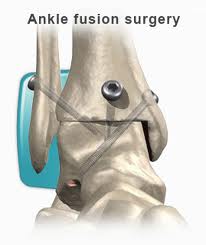Ankle Surgery - Pain, Replacement & Treatment
By Dr. Stuart Gold, M.D., Orthopedic Surgeon & Author
As the population of the United States ages, there will be an increasing demand for joint replacement surgeries. Hips, knees, ankles and other joints will need replacing in order for an older population to remain active and healthy. Hip and knee replacement surgeries are very common today and are considered routine surgery.
Another joint surgery that is not as well known is ankle replacement surgery; arthritis is not as common in the ankle as it is in other joints. Though ankle replacement is becoming more common, ankle fusion surgery is the standard surgical treatment to relieve ankle pain.

Who Typically Needs Ankle Surgery?
The average age for ankle replacement surgery is around 60 years of age. This is similar to the common ages for hip and knee replacement. Some patients are having the surgery done in their 40s, though doctors attempt to delay the procedure as long as possible. However, delaying the surgery is not always an option as there may be an optimum time to do the surgery. After this optimum time, it may be more difficult to perform the procedure.
Description of Ankle Surgery
Ankle surgery is usually done under general anesthesia. It is also possible to have spinal anesthesia, which means the patient will remain conscious but unable to feel anything below the waist. An incision is made and the surgeon will remove the damaged bone, reshape the remaining bones, and attach the new artificial joint. Special glue or screws may be utilized to hold the implant in place and a bone graft may be created to provide more support for the new ankle. Ankle surgery generally lasts around two hours but if there is more damage than normal, it may last longer.
Ankle Surgery Recovery
The normal hospital stay after ankle replacement or fusion surgery is one to two nights. Ankle replacement patients usually begin range of motion exercises on the second day and continue these exercises for one or two months before they are allowed to put full weight on the joint. Ankle fusion patients are immobilized for a few months. X-rays are typically taken to assess how well the fusion is healing and to assess the stability of the new components in the replacement.
If the X-ray looks good, the patient will then be allowed to put more weight on the ankle and begin walking. Occasionally full weight bearing may be delayed, but the vast majority of patients are walking by three months without the aid of crutches or a cane.
What Are The Risks Of Ankle Surgery Performed By An Orthopedic Surgeon?
There are risks associated with any surgical procedure and ankle surgery is no exception.
Wound complications are the most common problem after major ankle surgery. Pain after surgery should be present for several weeks after surgery. If the pain continues, and there is an associated wound problem an infection should be ruled out. Besides pain, the principle risks from anesthesia are allergic reactions and breathing problems. The risks from any surgical procedure include infection, excessive bleeding, and the potential for a blood clot.
Other risks associated with ankle surgery include failure of the fusion, nerve damage, and bone break during surgery, loosening of the artificial joint over time, ankle weakness and instability, and possible dislocation of the artificial ankle joint. If the alignment of the implant does not work and walking remains difficult several months after the surgery, the artificial joint may need to be removed and ankle fusion surgery would then need to be performed.

The Bottom Line on Ankle Surgery
Pain from a diseased or injured ankle can be debilitating and negatively affect a person‘s quality of life. Ankle surgery can be utilized to reduce pain and improve mobility. Before deciding on surgery, all options should be discussed with a doctor. Though ankle fusion surgery is the more common surgery now, ankle replacement will continue to become more prevalent as materials, designs, and surgical procedures improve.
> To learn more about ankle surgery, please click here.



